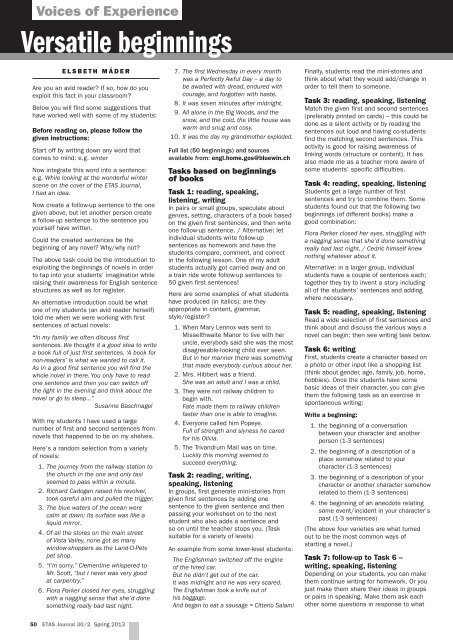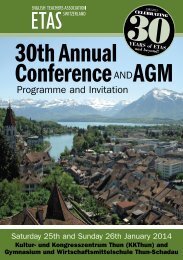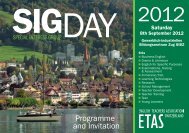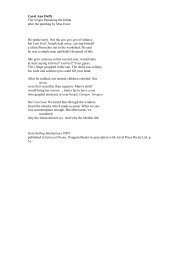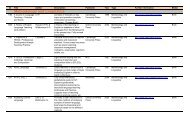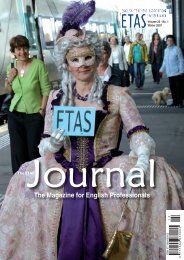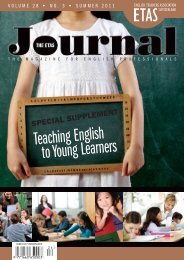Spring Journal 2013 - English Teachers Association of Switzerland
Spring Journal 2013 - English Teachers Association of Switzerland
Spring Journal 2013 - English Teachers Association of Switzerland
Create successful ePaper yourself
Turn your PDF publications into a flip-book with our unique Google optimized e-Paper software.
Voices <strong>of</strong> ExperienceVersatile beginningsE L S B E T H M Ä D E RAre you an avid reader? If so, how do youexploit this fact in your classroom?Below you will find some suggestions thathave worked well with some <strong>of</strong> my students:Before reading on, please follow thegiven instructions:Start <strong>of</strong>f by writing down any word thatcomes to mind: e.g. winterNow integrate this word into a sentence:e.g. While looking at the wonderful winterscene on the cover <strong>of</strong> the ETAS <strong>Journal</strong>,I had an idea.Now create a follow-up sentence to the onegiven above, but let another person createa follow-up sentence to the sentence youyourself have written.Could the created sentences be thebeginning <strong>of</strong> any novel? Why/why not?The above task could be the introduction toexploiting the beginnings <strong>of</strong> novels in orderto tap into your students’ imagination whileraising their awareness for <strong>English</strong> sentencestructures as well as for register.An alternative introduction could be whatone <strong>of</strong> my students (an avid reader herself)told me when we were working with firstsentences <strong>of</strong> actual novels:“In my family we <strong>of</strong>ten discuss firstsentences. We thought it a good idea to writea book full <strong>of</strong> just first sentences. ‘A book fornon-readers’ is what we wanted to call it.As in a good first sentence you will find thewhole novel in there. You only have to readone sentence and then you can switch <strong>of</strong>fthe light in the evening and think about thenovel or go to sleep...”Susanne BaschnagelWith my students I have used a largenumber <strong>of</strong> first and second sentences fromnovels that happened to be on my shelves.Here’s a random selection from a variety<strong>of</strong> novels:1. The journey from the railway station tothe church in the one and only taxiseemed to pass within a minute.2. Richard Cadogan raised his revolver,took careful aim and pulled the trigger.3. The blue waters <strong>of</strong> the ocean werecalm at dawn; its surface was like aliquid mirror.4. Of all the stores on the main street<strong>of</strong> Vista Valley, none got as manywindow-shoppers as the Land-O-Petspet shop.5. “I’m sorry,” Clementine whispered toMr. Scott, “but I never was very goodat carpentry.”6. Flora Parker closed her eyes, strugglingwith a nagging sense that she’d donesomething really bad last night.7. The first Wednesday in every monthwas a Perfectly Awful Day – a day tobe awaited with dread, endured withcourage, and forgotten with haste.8. It was seven minutes after midnight.9. All alone in the Big Woods, and thesnow, and the cold, the little house waswarm and snug and cosy.10. It was the day my grandmother exploded.Full list (50 beginnings) and sourcesavailable from: engl.home.gos@bluewin.chTasks based on beginnings<strong>of</strong> booksTask 1: reading, speaking,listening, writingIn pairs or small groups, speculate aboutgenres, setting, characters <strong>of</strong> a book basedon the given first sentences, and then writeone follow-up sentence. / Alternative: letindividual students write follow-upsentences as homework and have thestudents compare, comment, and correctin the following lesson. One <strong>of</strong> my adultstudents actually got carried away and ona train ride wrote follow-up sentences to50 given first sentences!Here are some examples <strong>of</strong> what studentshave produced (in italics): are theyappropriate in content, grammar,style/register?1. When Mary Lennox was sent toMisselthwaite Manor to live with heruncle, everybody said she was the mostdisagreeable-looking child ever seen.But in her manner there was somethingthat made everybody curious about her.2. Mrs. Hibbert was a friend.She was an adult and I was a child.3. They were not railway children tobegin with.Fate made them to railway childrenfaster than one is able to imagine.4. Everyone called him Popeye.Full <strong>of</strong> strength and slyness he caredfor his Olivia.5. The Trivandrum Mail was on time.Luckily this morning seemed tosucceed everything.Task 2: reading, writing,speaking, listeningIn groups, first generate mini-stories fromgiven first sentences by adding onesentence to the given sentence and thenpassing your worksheet on to the nextstudent who also adds a sentence andso on until the teacher stops you. (Tasksuitable for a variety <strong>of</strong> levels)An example from some lower-level students:The <strong>English</strong>man switched <strong>of</strong>f the engine<strong>of</strong> the hired car.But he didn’t get out <strong>of</strong> the car.It was midnight and he was very scared.The <strong>English</strong>man took a knife out <strong>of</strong>his baggage.And began to eat a sausage = Citterio SalamiFinally, students read the mini-stories andthink about what they would add/change inorder to tell them to someone.Task 3: reading, speaking, listeningMatch the given first and second sentences(preferably printed on cards) – this could bedone as a silent activity or by reading thesentences out loud and having co-studentsfind the matching second sentences. Thisactivity is good for raising awareness <strong>of</strong>linking words (structure or content). It hasalso made me as a teacher more aware <strong>of</strong>some students’ specific difficulties.Task 4: reading, speaking, listeningStudents get a large number <strong>of</strong> firstsentences and try to combine them. Somestudents found out that the following twobeginnings (<strong>of</strong> different books) make agood combination:Flora Parker closed her eyes, struggling witha nagging sense that she’d done somethingreally bad last night. / Cedric himself knewnothing whatever about it.Alternative: in a larger group, individualstudents have a couple <strong>of</strong> sentences each;together they try to invent a story includingall <strong>of</strong> the students’ sentences and addingwhere necessary.Task 5: reading, speaking, listeningRead a wide selection <strong>of</strong> first sentences andthink about and discuss the various ways anovel can begin; then see writing task below.Task 6: writingFirst, students create a character based ona photo or other input like a shopping list(think about gender, age, family, job, home,hobbies). Once the students have somebasic ideas <strong>of</strong> their character, you can givethem the following task as an exercise inspontaneous writing:Write a beginning:1. the beginning <strong>of</strong> a conversationbetween your character and anotherperson (1-3 sentences)2. the beginning <strong>of</strong> a description <strong>of</strong> aplace somehow related to yourcharacter (1-3 sentences)3. the beginning <strong>of</strong> a description <strong>of</strong> yourcharacter or another character somehowrelated to them (1-3 sentences)4. the beginning <strong>of</strong> an anecdote relatingsome event/incident in your character’spast (1-3 sentences)(The above four varieties are what turnedout to be the most common ways <strong>of</strong>starting a novel.)Task 7: follow-up to Task 6 –writing, speaking, listeningDepending on your students, you can makethem continue writing for homework. Or youjust make them share their ideas in groupsor pairs in speaking. Make them ask eachother some questions in response to what50 ETAS <strong>Journal</strong> 30/2 <strong>Spring</strong> <strong>2013</strong>


